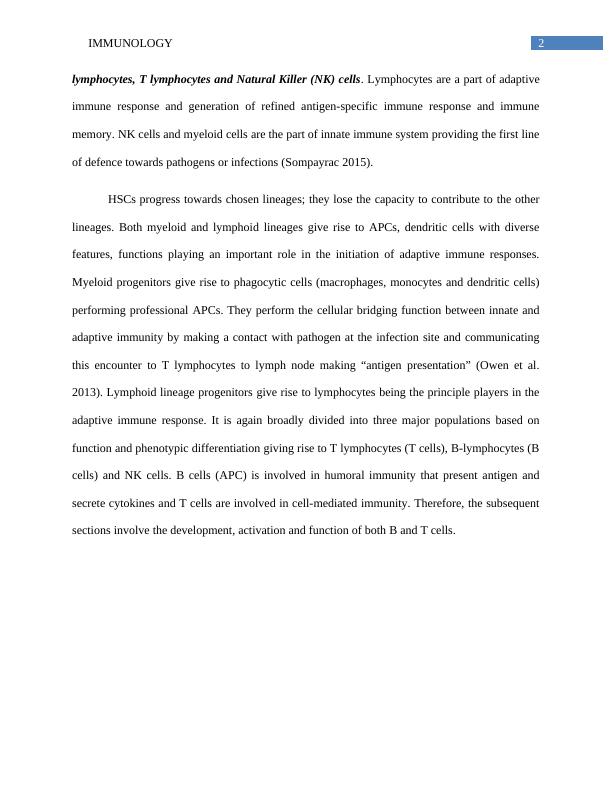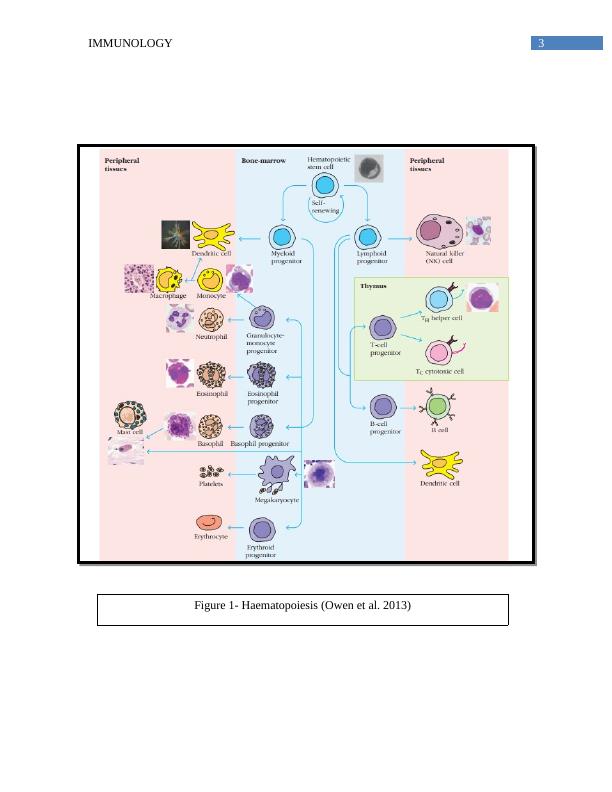Report on Immunology System
15 Pages3229 Words105 Views
Added on 2020-04-21
Report on Immunology System
Added on 2020-04-21
ShareRelated Documents
Running head: IMMUNOLOGYImmunologyName of the StudentName of the UniversityAuthor note

1IMMUNOLOGYAn immune system is responsible for producing responses to pathogens depending uponthe keen choreographed interactions among the diverse cells of the immune system (Parham2014). Two types of immunity: innate and acquired are produces immune response to fightagainst pathogens. For this, immune cells play the most important role providing the immunityand line of defence for the body. Immune cells of innate immunity provide the first line ofdefence against pathogens where antigen-presenting cells (APCs) communicate the pathogen tolymphoid cells coordinating to form adaptive response generating memory cells preventingfuture infections (Mauri and Bosma 2012). This coordination is mediated by immune systemorganized throughout the body in time and space. Specialized cells like mature red blood cells,macrophages, granulocytes, lymphocytes and dendritic cells are the immune cells that play themajor role in the immune system action. Therefore, the following discussion involves thedevelopment and functioning of immune system cells (myeloid and lymphoid lineage) united toperform functions as a whole. The specialized cells that function to perform immune activity arise from single cell type,hematopoietic stem cells (HSCs) via differentiation to form maturing blood cells by the processof haematopoiesis. In this process, self-renewing HSCs give rise to myeloid and lymphoidprogenitors forming mature immune cells in the bone marrow and them migrating to peripheralorgans via blood (Owen et al. 2013). Macrophages and mast cells also undergo maturation, butoutside bone marrow. B cells develop to maturity in bone marrow and T cells in the thymus. AnHSC is induced for haematopoiesis or differentiation losing its self-renewal capacity and breakdown into two broad lineage and commitment choices. Common myeloid-erythroid progenitor(CMP) gives rise to all the RBCs (erythroid lineage) monocytes, neutrophils, granulocytes andmacrophages (myeloid) or into common lymphoid progenitor (CLP) giving rise to B

2IMMUNOLOGYlymphocytes, T lymphocytes and Natural Killer (NK) cells. Lymphocytes are a part of adaptiveimmune response and generation of refined antigen-specific immune response and immunememory. NK cells and myeloid cells are the part of innate immune system providing the first lineof defence towards pathogens or infections (Sompayrac 2015). HSCs progress towards chosen lineages; they lose the capacity to contribute to the otherlineages. Both myeloid and lymphoid lineages give rise to APCs, dendritic cells with diversefeatures, functions playing an important role in the initiation of adaptive immune responses.Myeloid progenitors give rise to phagocytic cells (macrophages, monocytes and dendritic cells)performing professional APCs. They perform the cellular bridging function between innate andadaptive immunity by making a contact with pathogen at the infection site and communicatingthis encounter to T lymphocytes to lymph node making “antigen presentation” (Owen et al.2013). Lymphoid lineage progenitors give rise to lymphocytes being the principle players in theadaptive immune response. It is again broadly divided into three major populations based onfunction and phenotypic differentiation giving rise to T lymphocytes (T cells), B-lymphocytes (Bcells) and NK cells. B cells (APC) is involved in humoral immunity that present antigen andsecrete cytokines and T cells are involved in cell-mediated immunity. Therefore, the subsequentsections involve the development, activation and function of both B and T cells.

3IMMUNOLOGYFigure 1- Haematopoiesis (Owen et al. 2013)

End of preview
Want to access all the pages? Upload your documents or become a member.
Related Documents
Cytokines and Chemokines Assignment PDFlg...
|35
|921
|115
The Immune Systemlg...
|9
|2349
|89
Adaptive and Innate Immune System: Cytotoxic T-cells and Natural Killer Cellslg...
|11
|3537
|253
Immunity and Infectionlg...
|5
|1972
|422
